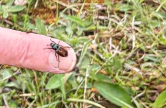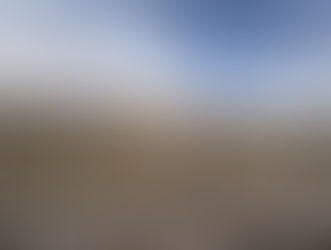Gordon D'Arcy, writer/artist
- Warren Berger

- Jun 19
- 5 min read
Updated: Oct 3
One afternoon during my May ’25 trip to the Burren, I arranged to meet Gordon D’Arcy at the pier in the town of Kinvara, near Gordon’s home.
Previously, as I was conducting advance research on the Burren, I had kept coming upon Gordon’s name. As I looked into local Burren artists, I noted that Gordon D’Arcy was one of those—an accomplished painter working in various styles and mediums. And as I sought to learn about the wildlife of the Burren, I discovered that Gordon D’Arcy had written books on the subject, with a particularly deep interest in native birds. He was an expert on local flowers, and also on the distinctive stone walls of the Burren (Gordon wrote a book on that, as well).
I figured out pretty quickly that if I’m writing about the Burren, Gordon was someone I needed to meet.

And meet him I did, recognizing him at the pier from an online photo: a trim man with a gray beard. We left my car parked there and I climbed into his, setting off for one of Gordon’s favorite spots in the Burren, the Slieve Carran Nature Reserve. This is a prime spot for spying rare Burren flowers and native birds—but it also features a cave once inhabited by a famous Irish hermit and that’s what I really wanted to see (because at times, I’m kind of a cave-dwelling hermit myself).
On the drive over, I learned a bit about Gordon’s personal history with the Burren. He came here from Belfast, Northern Ireland, almost half a century ago—at the time, he was escaping an area that was anything but peaceful and serene.
“When I discovered the Burren back then, it seemed like kind of a refuge from the Troubles of the north,” he told me. “I was immediately smitten by the place. The landscape touched me very deeply—I got this great sense of the past, the heritage of the place. And being a naturalist, I was struck by the richness of flora and fauna.” A few years later, Gordon and his wife Esther-Mary spent a winter in the Burren area; and the year after that, they packed up and moved there.
The flowers and birds of the Burren
Ever since Gordon and his wife moved to the Burren area, he has been exploring, writing about, painting, and teaching about the Burren at the Burren College of Art. When you walk with him here—as I did when we parked outside Slieve Carran and began a two-hour hike—you see a man in his element.
The nature reserve is rich in plant life, with Alpine flowers alongside Mediterranean ones, and woodland plants growing around and between exposed limestone. As we walk, Gordon can’t help but stop every minute or so, bending down to take a closer look at a particular species of flower and touch it gently. “They’re so small,” he murmurs.

“People expect large triffids,” Gordon says, but the Burren flowers are delicate and diminutive. Yet also hardy: “Anything that manages to get here survives,” he adds.
When a red and black butterfly flutters near one of the flowers we’re looking at, Gordon explains that it’s actually a moth, and not just any kind—it’s a Burnett Moth, poisonous to anything that might be foolish enough to swallow it. “Look at him flying around with impunity, knowing that no one is going to eat him,” Gordon says with amusement.
Some of the delicate flowers and insects I saw with Gordon.
As we walk along this “fertile rock” field, above us is a cliff known as Eagle’s Rock. The eagles who used to perch there are gone, but there are occasional appearances by ravens, peregrine falcons, or kestrels.
I remarked upon the various stone walls we see everywhere. “These walls are masterpieces of construction,” Gordon says, pointing out that, for example, the seemingly-random holes or openings in these walls were put there by design to allow wind to pass through; hence these stacked stones somehow hold together through centuries of storms.
“The people who built these walls,” Gordon says, “were engineers without knowing they were engineers.”
The hermit’s cave
Eventually, we come to a wooded area with a path that leads up to the cave of the hermit St. Colman, who lived quietly here for a seven-year stretch around the turn of the 6th century. The area includes the ruins of a small chapel and a holy well—Colman’s Well—with clear spring water emerging from under a limestone base; the water is said to cure eye ailments. As we arrive at the well, several people are sitting cross-legged on the ground beside it, eyes closed, meditating.
We continue uphill, walking between trees covered in fungi and lichens, until we reach the cave. It is tiny—just big enough for a man to lie down in it on a bed of straw. Colman is believed to have been accompanied, during his seven-year retreat, by a faithful servant. Did they both sleep in the cave? Or did Colman force the servant to sleep outside? (As I said to Gordon, either way it tells us something about Colman).
I climbed inside the small cave, squatting on all fours for a minute in there, looking to see if there was anything on the ground because Gordon had told me that in the past he’s found candle stumps, “which means people must be overnighting it in the cave.”

As we walked back down the hill, the rain started up—it comes and goes constantly in the Burren, but often it’s just a passing cloud—and we hustled back to the car and drove to Gordon’s house.
When we got to his home, I asked Gordon to show me his own “cave,” the place where he does his writing and painting. Gordon led me up to an A-frame studio built on top of his garage, with the kind of privacy and good light that made me want to create something there myself.

We came down from the studio to find Esther-Mary had set out tea and biscuits in the garden, and the three of us sat and discussed Irish hermits and other topics.
If you’re coming to the Burren and you need a good tour guide, I recommend Gordon. I did a second walk with him a couple of days later in the Burren National Park area, and this time Esther-Mary came along, as did my wife, Laura. We walked some grasslands and saw a few more tiny, rare flowers; learned about the temporary lakes called “turloughs;” heard a loud cuckoo’s birdcall; learned about the infamous famine roads (I'm standing on one in the photo below); and came away with an even greater appreciation of this unique region.
You can soak up some of Gordon’s vast knowledge of the Burren by reading his books, including his latest The Breathing Burren. All of his books, and much of his artwork, are featured on his website www.gordondarcynature.com.





























Comments